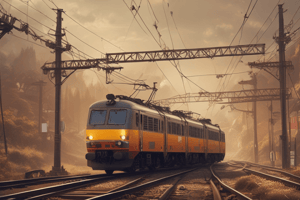Podcast
Questions and Answers
Q1: Departure Signals control entry into Block Sections where movements are?
Q1: Departure Signals control entry into Block Sections where movements are?
- C Signalled in one direction only. (correct)
- D Signalled into parallel tracks.
- B Signalled in both directions.
- A Signalled into back shunts.
Q2: What is the purpose of Departure Signals?
Q2: What is the purpose of Departure Signals?
- A To allow back shunts only.
- D To allow parallel track movements.
- C To allow movements in one direction only. (correct)
- B To allow movements in both directions.
Q3: How are movements controlled by Departure Signals?
Q3: How are movements controlled by Departure Signals?
- B They are signalled in both directions.
- D They are signalled into parallel tracks.
- C They are signalled in one direction only. (correct)
- A They are signalled into back shunts.
Which direction are Departure Signals usually signalled in?
Which direction are Departure Signals usually signalled in?
What does an Absolute signal indicate?
What does an Absolute signal indicate?
Who directly controls signals at an interlocked station?
Who directly controls signals at an interlocked station?
Flashcards are hidden until you start studying
Study Notes
Departure Signals Control Entry
- Departure signals control entry into Block Sections where movements are controlled.
- The purpose of Departure Signals is to ensure safe train movements by preventing collisions.
- Departure Signals control movements by indicating whether a train can proceed into the next block section or not.
- Departure Signals are usually signalled in the direction of travel.
- An Absolute signal indicates that a train can safely proceed into the next Block Section.
- Signals at an interlocked station are directly controlled by the Signaller.
Studying That Suits You
Use AI to generate personalized quizzes and flashcards to suit your learning preferences.




